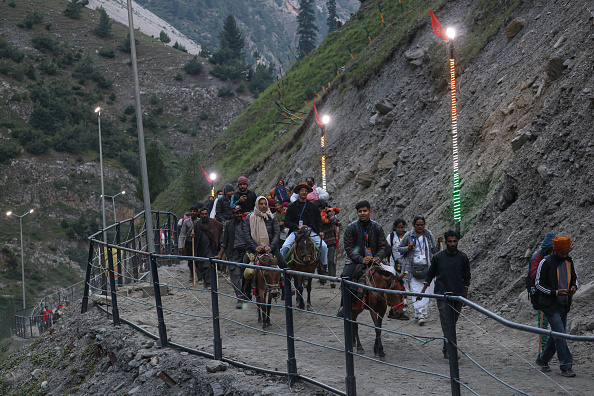Over 1.63 lakh devotees have performed the sacred Amarnath Yatra since it began on July 3, even as a fresh batch of 6,639 pilgrims departed from Jammu for Kashmir early Saturday morning.
According to officials, the pilgrims who have so far undertaken the yatra have successfully had ‘darshan’ at the holy cave shrine, which is situated at an altitude of 3,888 metres in the Himalayas of south Kashmir. On Saturday, two escorted convoys carrying the latest group of pilgrims left from Bhagwati Nagar Yatri Niwas in Jammu. The first convoy of 116 vehicles, carrying 2,337 yatris, departed at 2:50 a.m. for the Baltal base camp. The second convoy, consisting of 161 vehicles and 4,302 pilgrims, left at 3:55 a.m. for the Nunwan base camp near Pahalgam.
Meanwhile, the Bhumi Pujan ceremony of the sacred ‘Chhari Mubarak’ (Lord Shiva’s Holy Mace) was performed at Pahalgam on Thursday. The ceremonial mace was taken from the Dashnami Akhara Building in Srinagar by a group of sadhus led by Mahant Swami Deependra Giri, the sole custodian of the Chhari Mubarak. The procession carried the mace to the Gauri Shankar temple in Pahalgam, where the traditional Bhumi Pujan was conducted. The Chhari Mubarak is scheduled to reach the holy cave shrine on August 9, the final day of the yatra, which coincides with Shravan Purnima and Raksha Bandhan.
In light of heightened security concerns, particularly following the April 22 terror attack in Pahalgam’s Baisaran meadow that claimed 26 lives, authorities have deployed extensive multi-tier security arrangements. The central government has sent an additional 180 companies of Central Armed Police Forces (CAPFs) to reinforce existing deployments from the Army, BSF, CRPF, SSB, and local police.
The Indian Army has also launched a comprehensive security initiative named “Operation SHIVA 2025.” More than 8,500 troops have been deployed alongside advanced surveillance and combat technology to ensure the safety of pilgrims. The operation includes a dedicated counter-UAS (Unmanned Aerial System) grid with over 50 counter-drone and electronic warfare systems to tackle aerial threats.
Live monitoring via UAVs (drones) and PTZ (Pan-Tilt-Zoom) cameras is being used to track yatra convoys and activity near the cave shrine. Engineer task forces have been deployed to maintain and improve infrastructure along the route, including bridge construction, track widening, and landslide mitigation.
Medical preparedness has also been enhanced significantly. The Army has positioned more than 150 doctors and paramedics, two Advanced Dressing Stations, nine Medical Aid Posts, a 100-bed hospital, and 26 oxygen booths supported by 2 lakh litres of oxygen. Additional support includes bomb detection squads, technical detachments, and communication teams.
Transit camps, base camps, and the entire route from Jammu to the holy cave are under strict surveillance and protection. Notably, helicopter services have been suspended this year due to security concerns.
Pilgrims undertake the yatra to visit the naturally formed ice stalagmite inside the cave shrine, believed by devotees to represent Lord Shiva. The structure is known to wax and wane with the lunar cycle, reinforcing its mystical significance.
The Amarnath Yatra remains one of Hinduism’s holiest pilgrimages. According to legend, it was in this cave that Lord Shiva revealed the secrets of immortality and eternal life to Mata Parvati.
This year’s pilgrimage spans 38 days, with thousands of pilgrims trekking via the two main routes: the traditional 46-kilometre Pahalgam route, which typically takes four days, and the shorter 14-kilometre Baltal route, which allows pilgrims to complete the round-trip in a single day.
(With agencies inputs)














